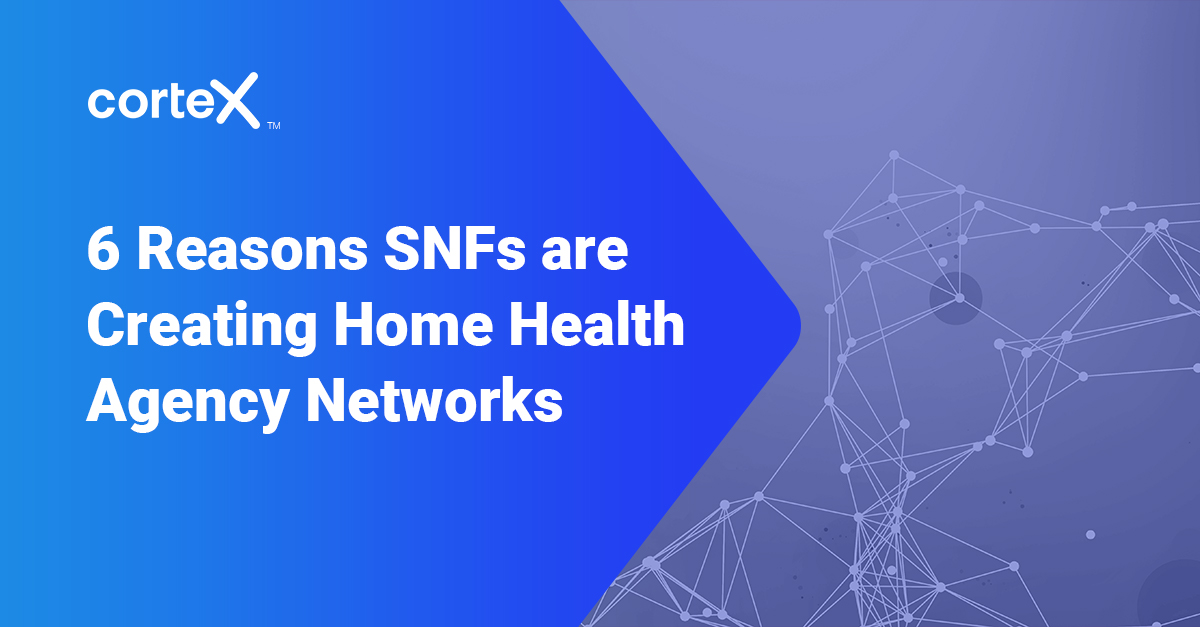Poorly coordinated care is unsafe for patients and expensive for the health care system.

Research shows that poor coordination of care leads to higher hospital readmission rates, high rates of medication errors, incomplete or inaccurate information transfer, and lack of appropriate follow-up care for patients during transitions. This compromises care quality and patient safety.
Integration of care also called interoperability is necessary to improve patient outcomes. That’s why Skilled Nursing Facilities are creating a network of Home Health Agencies.
Here are the six benefits of integrating care with a preferred network:
1. Partner with providers you trust
Whenever a patient is transferred, there’s always the risk that they’ll land in the hands of an unaccountable provider. It’s important to assess an HHA by standardized quality measures in order to determine whether or not you should recommend them to patients.
The Centers for Medicare and Medicaid Services ranks HHA’s using these four quality measures:
- Improvement measures (measures describing a patient’s ability to get around, perform activities of daily living, and general health)
- Measures of potentially avoidable events (markers for potential problems in care)
- Utilization of care measures (measures describing how often patients access other health care resources either while home health care is in progress or after home health care is completed)
- Cost/Resource measures
Think of each of these measures as a potential risk/benefit to your patients. Consider each of them when creating a network of HHA’s.
Ready to get started? Cortex gives you easy access to performance data on HHA’s so you can quickly and easily partner with HHA’s that you trust, lowering risk to patients and decreasing overall costs over time.
2. Seamless transfer of patient data
Thorough transfer of patient data is huge when it comes to patient outcomes. There’s a big risk of information getting lost as the patient travels from provider to provider. In fact, missing or inaccurate patient data is one of the biggest determinants of hospital readmission rates.
Partnering with an integrated group of HHA’s allows you to set up a system to transfer patient data so that accurate care is possible. All providers can stay in-tune with the patient and follow their progress.
Cortex’s Transition Manager helps you coordinate care across providers, streamlining communication and ensuring that everyone is up-to-date and on the entire history of care and patient needs.
3. Quick & efficient transition
When you’re dealing with large volumes of discharges, it’s much easier to plan patient care with a limited subset of trusted HHAs. Instead of evaluating HHA’s on a patient-by-patient basis, you can quickly access your network and find a spot for your patient quickly. This saves you time and resources and results in better patient outcomes.
4. Improve positioning with hospitals
When it comes to establishing partnerships with hospitals, having an HHA network will make you stand out from the competition. You can show hospital administrators valuable statistics derived from your profitable partnerships, including lower readmission rates.
This will affect your bottom line. Firstly, you’ll get the opportunity to acquire more business from hospitals. Secondly, research shows that hospital-SNF pairs that are vertically integrated receive higher total Medicare payments than those who aren’t.
5. Receive incentive payments for lower readmission rates
Generally, high readmission rates are seen as a result of low-quality care and cost-ineffective. Establishing a care network can help you lower readmission rates and establish better partnerships with hospitals.
In 2012, the Affordable Care Act established a penalty program for preventable readmissions with hospitals and, later, an incentive program with SNF’s. Medicare rewards SNF’s with incentive payments based on hospital readmission rates. The Skilled Nursing Facility Value-Based Purchasing (SNF VBP) Program includes all SNFs paid under Medicare’s SNF Prospective Payment System (PPS).
6. Higher patient satisfaction
Better care means more satisfied patients. At the end of the day, a patient’s health and happiness is the primary goal of all healthcare providers.
Get Started with Cortex’s Network Manager
Cortex helps you manage patient recovery with real-time insights into their post-acute networks. If you’re forming a preferred-network or want to assess performance across all of your post-acute partners, Cortex can help.
Networks can measure post-acute providers in real-time, making partners accountable for patient outcomes. This network data can also help you spotlight the best performers, lowering risk and decreasing costs over time.




